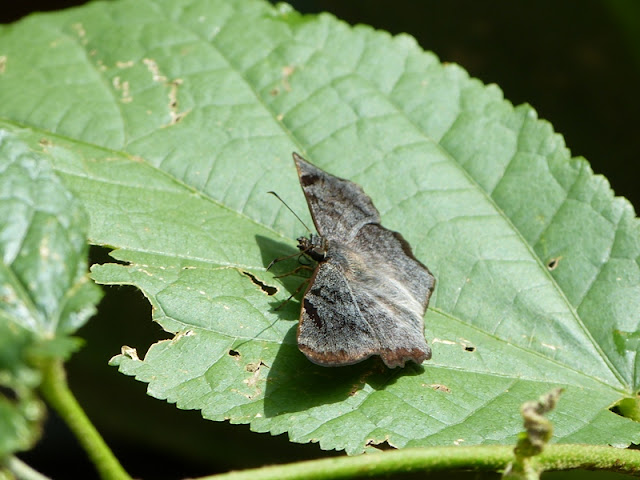As it turned out we woke up on our last morning to beautiful blue skies. We had to leave for the airport at midday, but after breakfast we installed ourselves next to one of the swimming pools for the morning.
I was just blown away by the number of butterflies that were flying around the hotel grounds that morning. There were continuously about three or four in vision at any one time. Many of them I was now able to identify as they flew past, but there were quite a few unfamiliar ones, too. Better still, possibly because they had limited opportunities to fly or feed the previous few days, many of them stopped off at plants to feed, or even lay eggs.
Despite really feeling that I should spend the last morning of our holiday with my wife, I couldn’t resist chasing after the odd butterfly with my camera! This White-angled Sulphur, Anteos clorinde, was so absorbed with feeding on this Ixora hedge that it allowed me to get close enough to photograph it. Previously I had only seen them feeding high up in Mimosa trees.
It even opened its wings slightly allowing me to see the yellow mark on its upper wing.
It was joined by another white butterfly – a Giant White, Ganyra josephina, which I hadn’t seen previously.
The Ixora hedge was proving to be a real magnet with various skippers (mentioned in my previous post) and other butterflies feeding from it.
A third white butterfly settled on a nearby plant, allowing me to identify it as a Florida White, Appias drusilla. This confirmed my suspicion that I had seen these along the track through the woods.
A little later a tiny yellow butterfly flew past. I was soon in hot pursuit and luckily it stopped to lay some eggs on a weed in a shady spot. I managed to identify it as a Mimosa Yellow, Pyrisitia nise. I had seen similar little yellow butterflies flying through the grounds earlier in our holiday, but they had never stopped, so this was a bonus for me on our last day!
But to top it off I saw a dark swallowtail flying backwards and forwards over an Orange Jasmine shrub by the pool. As I watched it buried into the hedge and started laying eggs. It turned out to be a Ruby-patched Swallowtail, Heraclides isidorus. Such an exciting butterfly to see as my last species of the trip. I later learned that unusually for swallowtails, they lay their eggs in batches, rather than singly.
Eventually we had to tear ourselves away from the pool and get ready to leave the hotel. The journey to the airport was our only real opportunity to see more of the country. I just couldn’t believe the number of butterflies of all shapes, sizes and colours in the verges and surrounding countryside. I felt a mix of delight at seeing them, but tinged with sadness, as I really would have loved to have stopped all the way along the journey to take closer looks!
Of course Costa Rica had the last laugh. While we were waiting for our plane to arrive at the airport I noticed that it was getting darker. Eventually the plane arrived in a tremendous thunder storm that was still going as we took off. I had expected the flight to be delayed while the storm passed, but that wasn’t the case. I have to admit that I was very relieved once we were off the ground and above the storm and it was interesting looking down on the lightening below!
This was meant to be a one-off, holiday of a lifetime. Despite the tropical storm for virtually the whole time we were there, it was an amazing experience. I have never been anywhere where there is so much wildlife, which doesn’t seem to have any fear of humans. And of particular interest to me were the butterflies and I have certainly never been anywhere where I have seen so many. It took me a while after I got home to identify them all, but I managed to identify 68 different species. I can only imagine how many more species I could have seen if the weather had been good and if we had managed to travel to other parts of the country. Now I feel I have unfinished business!
I will definitely have to go back!!
.jpg)






.jpg)
.jpg)
































